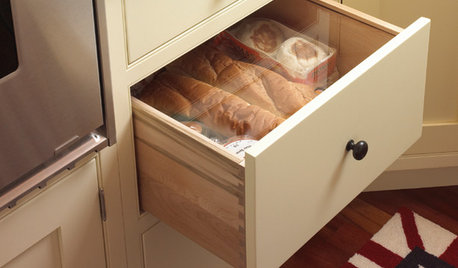Bread questions: Homemade vs Store
caflowerluver
12 years ago
Related Stories

ORGANIZINGPre-Storage Checklist: 10 Questions to Ask Yourself Before You Store
Wait, stop. Do you really need to keep that item you’re about to put into storage?
Full Story
KITCHEN DESIGNKitchen Ideas for Bread Lovers
Any way you slice it, a kitchen designed with bread in mind conveys warmth and homeyness
Full Story
OUTDOOR PROJECTSBring In the Birds With a Homemade Bubble Rock
An avian expert from Southern Indiana shows how to make a burbling fountain that migrating birds will love
Full Story
BEDROOMS13 Homemade Headboards That Thrill With Creativity
Snipped from a trellis, snagged from a pallet pile and more, these inventive headboards excite in any bedroom
Full Story
KITCHEN DESIGN9 Questions to Ask When Planning a Kitchen Pantry
Avoid blunders and get the storage space and layout you need by asking these questions before you begin
Full Story
KITCHEN DESIGNKitchen Luxuries: The Wood-Fired Pizza Oven
If you love homemade pizza and are (ahem) rolling in dough, a wood-burning oven may be just the right kitchen investment
Full Story
KITCHEN DESIGNA Cook’s 6 Tips for Buying Kitchen Appliances
An avid home chef answers tricky questions about choosing the right oven, stovetop, vent hood and more
Full Story
HOLIDAYSA Fresh and Fun Hanukkah Dessert Table and Wrapping Station
Celebrate the Festival of Lights with gelt pouches, homemade snacks and wrapping supplies as pretty as any party decor
Full Story
APARTMENTSMy Houzz: Vintage Whimsy in a College Apartment in New Orleans
A graphic design student fills her first rental with childhood mementos, consignment store finds and budget-friendly DIY style
Full Story
FURNITURESmart Shopper: How to Judge Antique Furniture Quality
Pick the treasures from the trash without expert experience by learning how to evaluate antiques and what questions to ask
Full Story



grainlady_ks
teresa_nc7
Related Discussions
Cost Benefit Analysis Store Bought Bread vs Homemade
Q
Homemade laundry soap vs. Charlies Soap?
Q
Homemade Pickle Question
Q
OT... how to make homemade bread
Q
caflowerluverOriginal Author
annie1992
bryansda
cloudy_christine
sally2_gw
Jasdip
sheesh
ci_lantro
teresa_nc7
caflowerluverOriginal Author
grainlady_ks
Jasdip
caflowerluverOriginal Author
donnar57
oasisowner
caflowerluverOriginal Author
Lars
grainlady_ks
Lars
hawk307
caflowerluverOriginal Author
caflowerluverOriginal Author
grainlady_ks
Jasdip
arkansas girl
Jasdip
jessicavanderhoff
grainlady_ks
Jasdip
grainlady_ks
hawk307